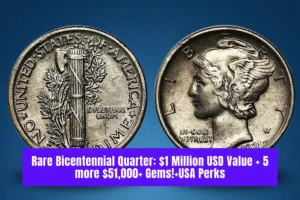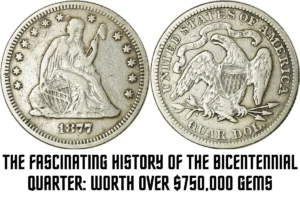Hey coin collectors and enthusiasts!
Ever wondered if there’s more to those Bicentennial Quarters than meets the eye?
Buckle up as we embark on a journey to uncover the secret features that make these coins not just pocket change but hidden treasures for your collection.
Get ready to boost your coin game!
The Bicentennial Buzz
Before we dive into the hidden features, let’s set the stage.
The Bicentennial Quarters were minted in 1976 to commemorate the 200th anniversary of the United States.
These quarters hold historical significance and, as we’ll discover, some sneaky secrets that can elevate your collection.
Revolutionary Roots: The Story Behind Bicentennial Quarters
Picture this: the bicentennial celebration of the birth of the nation.
The U.S. Mint decided to mark the occasion with a unique quarter design, showcasing the iconic Independence Hall in Philadelphia and a powerful eagle.
Little did we know, there’s more to this design than meets the eye.
Feature 1: Drumroll for the “D” Mint Mark
You might think a mint mark is just a tiny detail, but oh, the stories it can tell!
Bicentennial Quarters come in two varieties – one with a “D” mint mark and the other with a “P” mint mark.
The “D” stands for Denver, and it turns out, it’s not just a geographical detail.
Denver Drama: The “D” Mint Mark’s Rarity

The quarters bearing the “D” mint mark were primarily intended for circulation in the western U.S.
Unbeknownst to many, the Denver-minted Bicentennial Quarters are a bit rarer than their Philadelphia counterparts, making them a sweet find for collectors.
Feature 2: The Secret Date Code
Dates on coins – straightforward, right?
Not so fast!
The Bicentennial Quarters have a subtle date code hiding in plain sight.
Ever wondered why the date seems to have a couple of extra digits?
Date Decoder: Cracking the Bicentennial Date Code

Take a closer look at the dual dates – 1776-1976.
The secret lies in the six-digit code, where the first two numbers represent the bicentennial celebration.
Quarters with a 1776-1976 date and a “D” mint mark are like the hidden gems of your collection.
Feature 3: S Mint Mark Surprise
Now, let’s add a dash of spice with the elusive “S” mint mark.
San Francisco, stand up! Bicentennial Quarters with the “S” mint mark are not your everyday find, and that’s precisely what makes them a collector’s dream.
S for Surprise: San Francisco’s Mint Mark Magic

Quarters minted in San Francisco with the “S” mark were primarily produced for proof sets, making them less common in everyday circulation.
Spotting one in your collection is like finding a needle in a haystack – rare, but oh-so-rewarding.
Feature 4: Hidden Designer Initials
The creators of these quarters left a subtle mark of their own – hidden designer initials.
If you haven’t already, grab a magnifying glass and explore the intricacies of the Independence Hall on the reverse side.
You might just stumble upon a tiny “FW.”
Designer’s Signature: Unveiling the “FW” Initials

The initials “FW” belong to Frank Gasparro, the Chief Engraver of the U.S. Mint at the time.
Spotting these hidden initials adds a personal touch to your Bicentennial Quarter and lets you connect with the talented hands behind the design.
Feature 5: The Copper Core Conspiracy
Underneath the silver-colored surface of Bicentennial Quarters lies a secret – a copper core.
This hidden core adds a layer of complexity and uniqueness to these coins.
Ever wondered why they seem to wear differently than your regular quarters?
Copper Core Chronicles: The Durability of Bicentennial Quarters

The copper core contributes to the distinctive appearance of these quarters over time.
As they age, Bicentennial Quarters might reveal a warmer hue, creating a visual journey through the years.
It’s like watching history unfold in the palm of your hand.
Feature 6: The Collector’s Edge: Uncirculated Bicentennial Quarters
Uncirculated coins – the holy grail for collectors.
Bicentennial Quarters in mint condition with no signs of wear are a special find.
They carry an untouched beauty that adds a touch of exclusivity to your collection.
Minted Marvels: The Allure of Uncirculated Bicentennial Quarters

Uncirculated quarters retain their original luster and details, offering a pristine glimpse into the past.
If you’re lucky enough to stumble upon uncirculated Bicentennial Quarters, consider your collection taken to the next level.
Conclusion
And there you have it – the 6 secret features of rare Bicentennial Quarters that can take your coin collection from ordinary to extraordinary.
From mint marks to hidden initials, each element adds a layer of intrigue and excitement to these historical coins.
FAQs
Q1: Are Bicentennial Quarters valuable?
Yes, some Bicentennial Quarters, especially those with certain mint marks or in uncirculated condition, can be valuable to collectors.
Q2: How can I tell if a Bicentennial Quarter is uncirculated?
Look for quarters with no signs of wear, scratches, or fading. Uncirculated coins will have their original luster and details intact.
Q3: Are Bicentennial Quarters still in circulation?
While Bicentennial Quarters are no longer minted, you might still come across them in your everyday pocket change.
Q4: Why do some Bicentennial Quarters look different?
The differences in appearance, such as color changes, can be attributed to the copper core of Bicentennial Quarters reacting to environmental factors over time.
Q5: Where can I find more information about Bicentennial Quarters?
For more in-depth information and details about Bicentennial Quarters, you can consult coin collecting guides, visit numismatic websites, or connect with fellow collectors in online forums.




